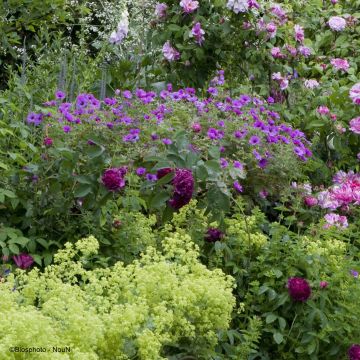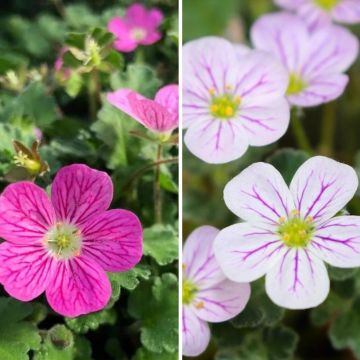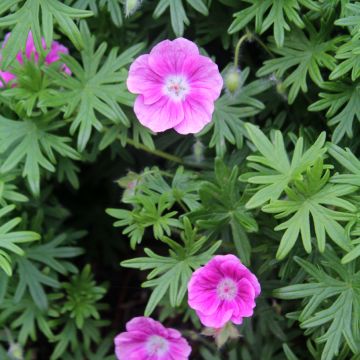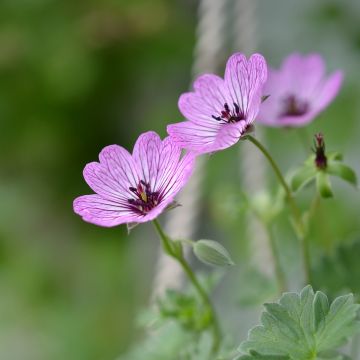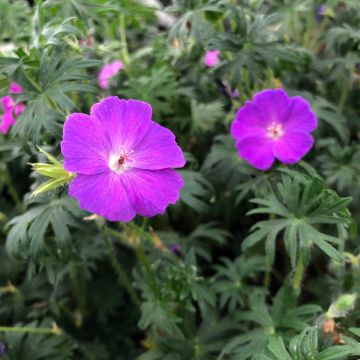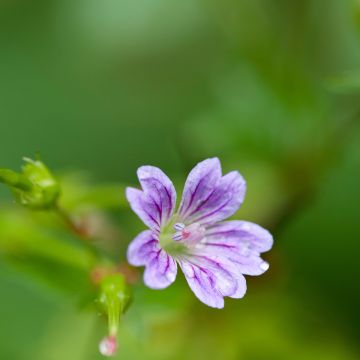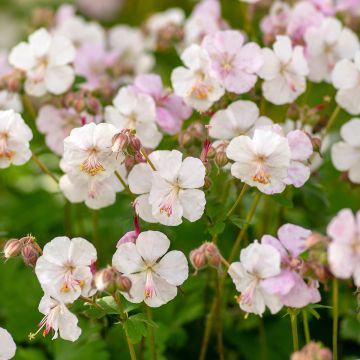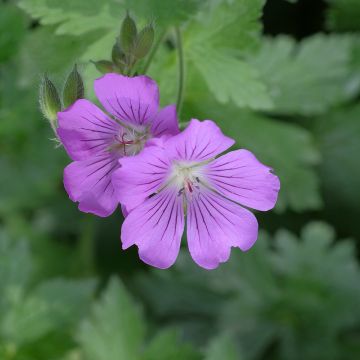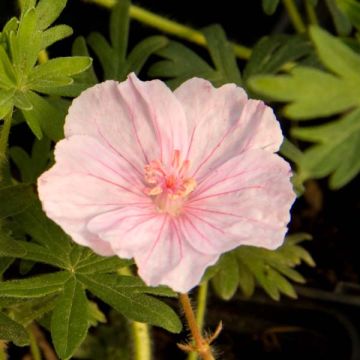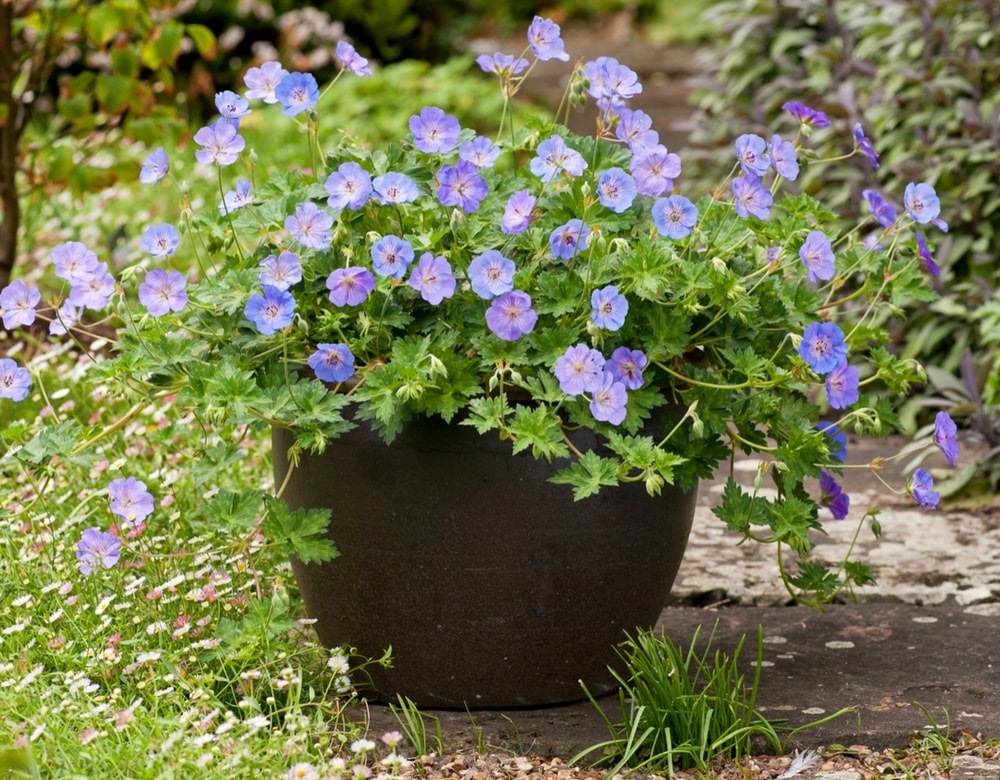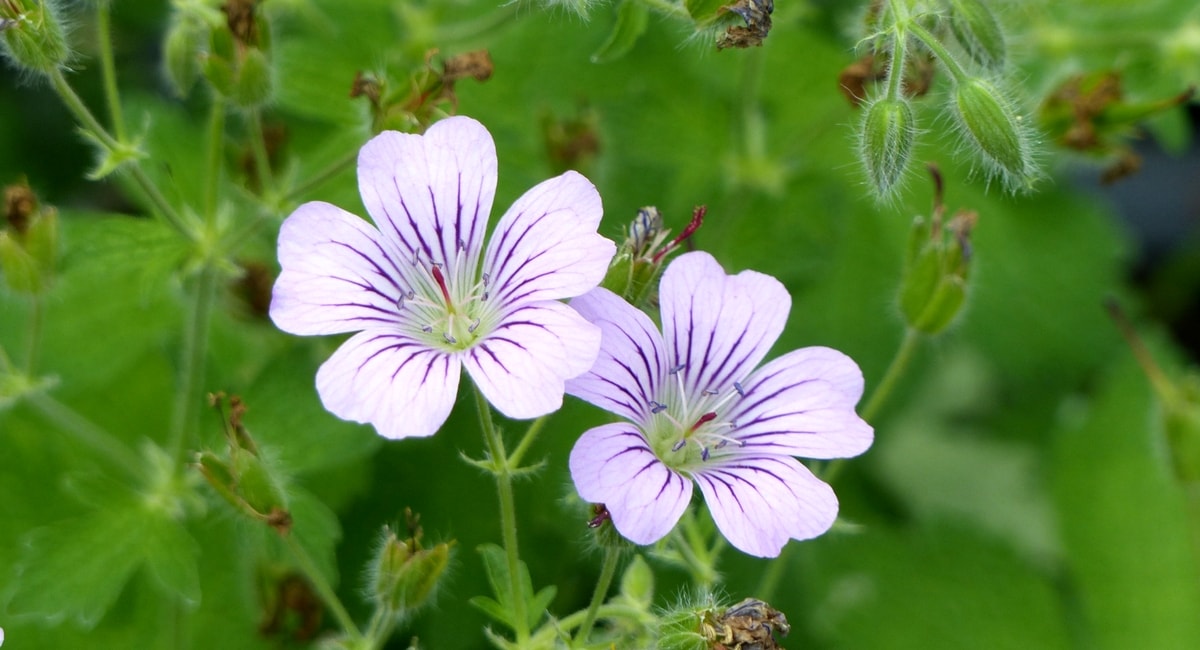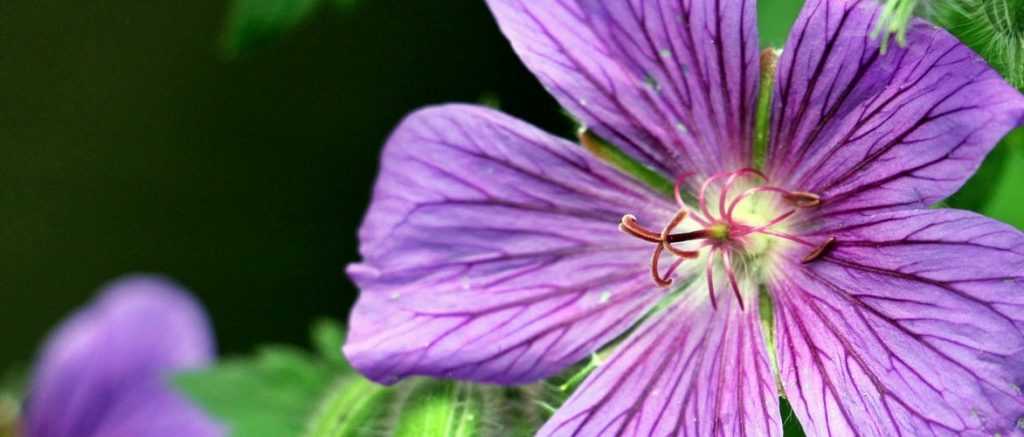
Perennial Geraniums: Planting, Growing and Caring
Contents
Perennial geraniums in a nutshell
- Geraniums captivate us with their generous flowering, which can sometimes last for over 6 months!
- Their flowers offer a wide range of soft-hued colours: pink, blue, white or mauve.
- They boast superb foliage, sometimes evergreen
- They make excellent ground cover, with dense foliage preventing weeds from growing
- Depending on the variety, they adapt well to container growing, rockeries or as ground cover at the base of trees and shrubs
- Easy to grow, these are robust plants with little susceptibility to disease
Our Expert's Word
Hardy geraniums offer a very long flowering period, which can last over six months depending on the variety! They bear delicate flowers and ornamental foliage, sometimes evergreen. They form beautiful clumps or thick carpets of leaves. They are often confused with pelargoniums, which share the same common name and whose vibrant blooms adorn window boxes. This is a shame, as true geraniums have the advantage of thriving in open ground, are completely hardy and low-maintenance! They have a much more natural appearance than pelargoniums.
Geraniums are vigorous and fairly easy to grow. They are resistant to diseases and help suppress weeds… These perennials are perfect for creating a flowering garden with minimal upkeep! What’s more, there’s a variety for every situation: full sun or shade, dry or moist soils… and even dry shade! Some geraniums will thrive in a sunny rock garden, while others are perfect for woodland areas with cool soil. They work well in flower beds, make excellent ground cover beneath trees or shrubs, and can also grow in containers, brightening up balconies and windowsills.
Botany
Botanical data
- Latin name Geranium sp.
- Family Geraniaceae
- Common name Cranesbill, Hardy Geranium
- Flowering from May to September
- Height typically 20 to 60 cm... and up to 1.50 m for Geranium maderense!
- Exposure sun or partial shade
- Soil type rich, moist but well-drained, without excess moisture
- Hardiness -20°C for most varieties
Hardy geraniums include nearly 400 species and over a thousand cultivated varieties! These are generally perennial plants, though some are annual or biennial. Their foliage is often deciduous, but can also be evergreen or semi-evergreen. They are quite hardy and vigorous.
Found on almost every continent, hardy geraniums have a wide global distribution. Many species occur in mountainous areas of temperate regions and in the eastern Mediterranean (Balkans, etc.). They are commonly found in the wild in France, which explains their excellent hardiness. With the exception of Madeira geranium, they are well-suited to the French climate! The most common wild species in France is probably Herb Robert (Geranium robertianum), which you’ll find along woodland paths or on old stone walls. Unlike garden geraniums, it has an annual or biennial life cycle.
Hardy geraniums are frequently confused with pelargoniums, those balcony plants often called “geraniums”. However, pelargoniums have irregular flowers (upper and lower petals differ), are much less hardy, and have thicker leaves and stems. They mainly originate from South Africa, while hardy geraniums are native to temperate zones!
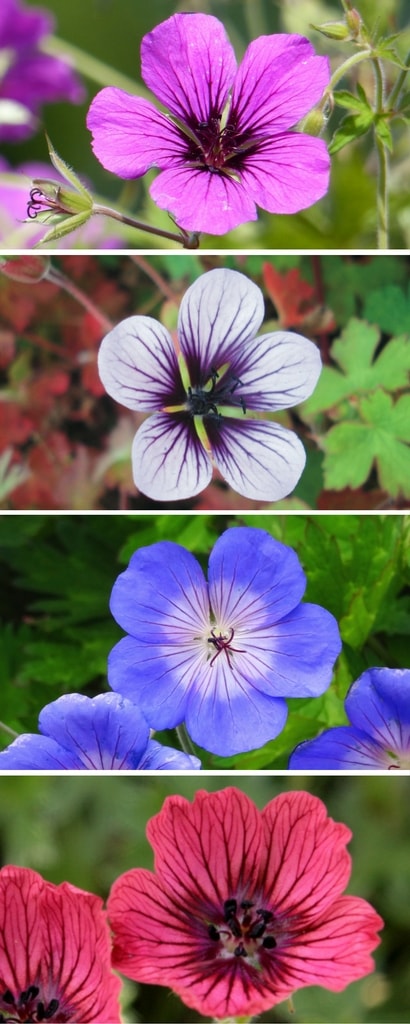
Hardy geraniums offer a beautiful colour range! From top to bottom: Geranium ‘Patricia’, Geranium ‘Salomé’, Geranium ‘Rozanne’ and Geranium cinereum ‘Jolly Jewel Salmon’
The hardy geranium belongs, along with pelargoniums and erodiums, to the Geraniaceae family, which it lends its name to and which includes nearly 800 species. Etymologically, “geranium” comes from the Greek geranos, meaning crane, as its seed pods resemble a crane’s bill – hence the common name “cranesbill”. Interestingly, Erodium and Pelargonium names refer respectively to heron and stork bills!
Hardy geraniums form clumps of varying compactness or ground-covering mats of leaves, making them excellent ground cover. Some grow in upright clumps, like Geranium psilostemon. Their height varies greatly: many varieties reach 20-30 cm, some up to 60 cm… and even 1.50 m for the Madeira geranium (though this is exceptional!)
The flowers are mostly simple with five petals, measuring 2-6 cm across. Their blooms are classic yet delicate, with fairly broad petals that are sometimes notched at the tips. Some varieties like Geranium himalayense ‘Plenum’ have double flowers for a more sophisticated look. Depending on petal shape, some appear star-like, such as Geranium ‘Catherine Deneuve’.
Flowers come in beautiful shades of pink, mauve, blue or white. Some are dark purple, like Geranium phaeum. Bicoloured varieties exist too, with contrasting centres – sometimes nearly black, as in Geranium psilostemon. Many feature dark veining radiating from the centre. Geranium versicolor has strikingly veined white petals creating a lacy effect.
Hardy geraniums can flower from spring to autumn, depending on variety. Some bloom first in late spring, then again in late summer – this reblooming is encouraged by summer pruning. Certain varieties like ‘Patricia’ can flower for over six months!
They bear ornamental foliage, often deeply cut. Leaves are palmately shaped with rounded or pointed segments. Geranium renardii has very rounded, barely lobed leaves, while Geranium sanguineum foliage is deeply divided. Some are aromatic (like Geranium macrorrhizum with its lemon scent when crushed) or sticky-hairy.
Though mostly green, foliage can turn deep purple, as with Geranium pratense ‘Purple Ghost’. Some develop stunning autumn colours in red, orange or bronze – notably Geranium macrorrhizum, Geranium wlassovianum and Geranium sanguineum.


The diversity of hardy geranium foliage! Left to right: Geranium maculatum, Geranium renardii, Geranium ‘Bob’s Blunder’ and Geranium nodosum (photo Benjamin Zwittnig)
Most varieties are deciduous, but some like Geranium x cantabrigiense or Geranium cinereum are evergreen. Others retain leaves only in mild winters.
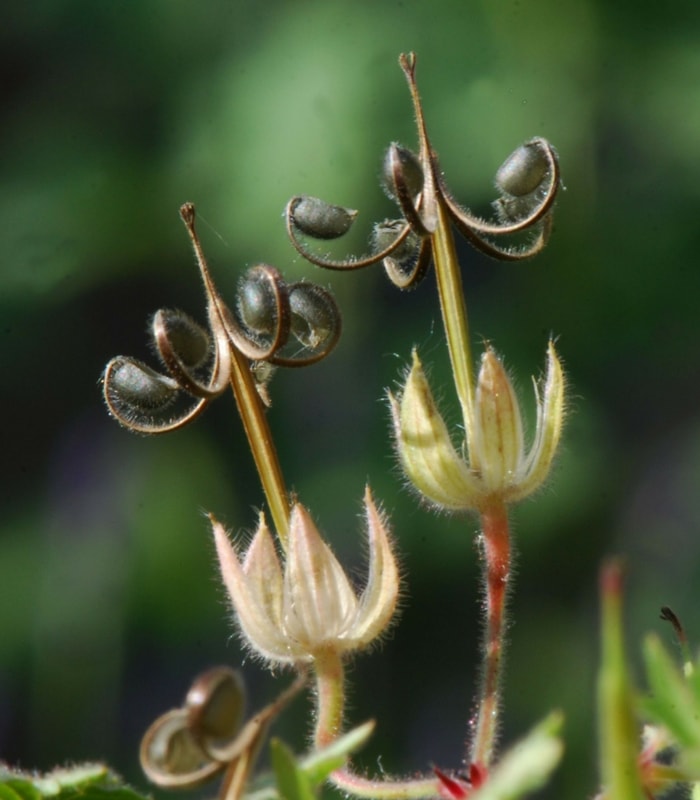
Fruits of Geranium rotundifolium (photo Pancrat)
The seed pods resemble slender crane’s bills. Remarkably, at maturity a tension mechanism suddenly ejects the five seeds up to several centimetres away!
Some varieties spread via rhizomes – Geranium macrorrhizum is named for its thick rhizomes. Others form non-spreading clumps. Tuberous species like Geranium tuberosum flower in spring then go summer-dormant.
Species and varieties
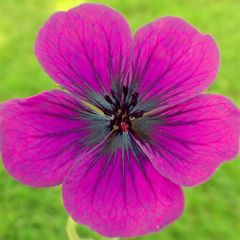
Geranium Dragon Heart
- Flowering time July to November
- Height at maturity 60 cm
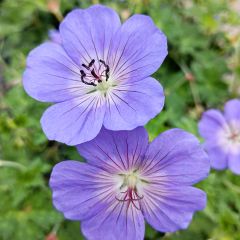
Geranium Rozanne
- Flowering time July to November
- Height at maturity 25 cm
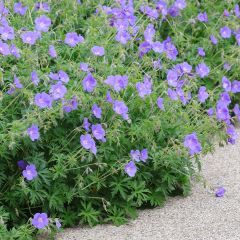
Geranium Orion
- Flowering time July to December
- Height at maturity 60 cm
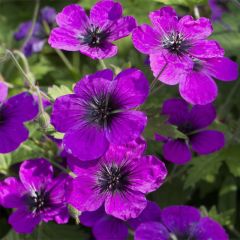
Geranium Patricia
- Flowering time July to December
- Height at maturity 50 cm
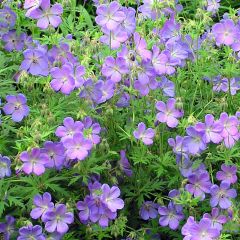
Geranium Johnsons blue
- Flowering time June to September
- Height at maturity 50 cm
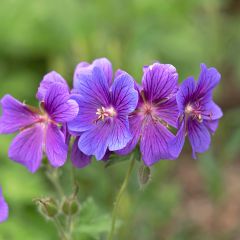
Geranium magnificum
- Flowering time July, August
- Height at maturity 60 cm
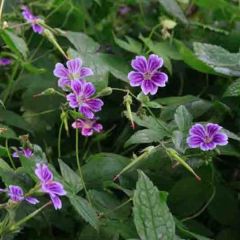
Geranium nodosum Clos du Coudray
- Flowering time July to October
- Height at maturity 50 cm
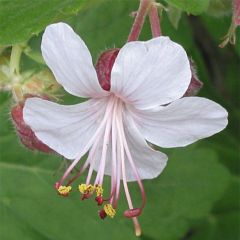
Geranium macrorrhizum Spessart
- Flowering time June, July
- Height at maturity 30 cm
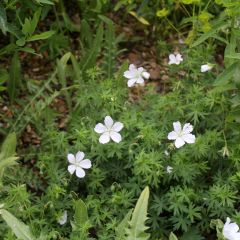
Geranium sanguineum Album
- Flowering time July to October
- Height at maturity 25 cm
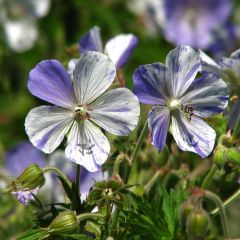
Geranium pratense Splish Splash
- Flowering time July to September
- Height at maturity 50 cm
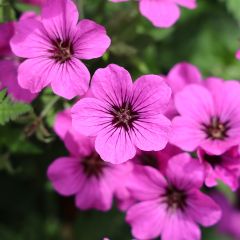
Geranium psilostemon - Armenian Cranesbill
- Flowering time July to September
- Height at maturity 80 cm
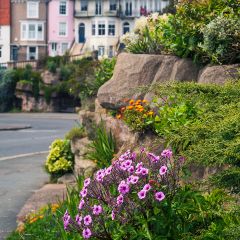
Geranium maderense
- Flowering time June, July
- Height at maturity 1,20 m

Geranium versicolor
- Flowering time June, July
- Height at maturity 30 cm
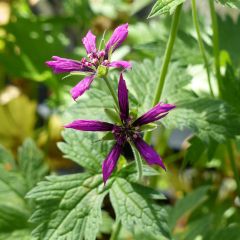
Geranium psilostemon Catherine Deneuve
- Flowering time June to September
- Height at maturity 50 cm
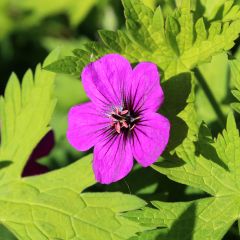
Geranium Ann Folkard
- Flowering time July to November
- Height at maturity 40 cm
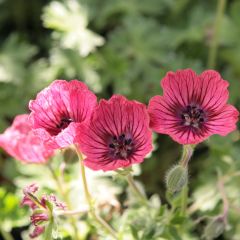
Geranium cinereum Jolly Jewel Salmon
- Flowering time July to September
- Height at maturity 20 cm
Finding it hard to choose? Let our guide help: “Perennial Geraniums: How to Choose?”
Discover other Hardy Geranium - Cranesbill
Perennial Geranium Planting
Where to plant?
Most geraniums thrive in full sun or partial shade. The best species for shady areas are Geranium nodosum, which tolerates dry shade, and Geranium maculatum, which prefers moister soil.
Geraniums are fairly undemanding when it comes to soil type. Generally, they prefer rich, humus-rich soils that are light and well-draining, yet remain moist in summer. Avoid waterlogged conditions, as geraniums dislike excess water. They thrive in neutral or slightly acidic soils. Geranium sanguineum is one of the most adaptable, tolerating poor, dry, and stony soils.
When to plant?
You can plant geraniums in spring, after the last frosts, or in autumn.
How to plant?
We recommend enriching the soil with compost. Space plants at least 40 cm apart to allow room for growth. Compact varieties like Geranium cinereum can be planted more densely, while spreading types (e.g., ‘Rozanne’ or ‘Ann Folkard’) need more space.
- Soak the root ball in a bucket of water to help the plant establish.
- Dig a hole 2–3 times the size of the root ball and add a few handfuls of compost or potting soil.
- Remove the plant from its pot. Gently loosen the root ball and untangle any circling roots.
- Position the geranium.
- Backfill with soil and firm gently around the plant.
- Water thoroughly.
Continue watering regularly in the weeks after planting. Your geranium will flower within the year!
Container planting:
You can grow geraniums in pots or containers. Some varieties produce long stems that cascade beautifully over the edges! Pair them with complementary plants.
Prepare a mix of potting soil and sand. Choose a deep pot and add clay pebbles at the base for drainage. Add the substrate, position the root ball, backfill, and firm. Water well.
For a full guide on planting hardy geraniums, see our advice sheet: “How to Plant Hardy Geraniums”
Maintenance
Once established, geraniums require very little maintenance! These are undemanding plants that can fend for themselves. Their dense foliage has the advantage of preventing weeds from growing!
Geraniums are hardy plants and are rarely affected by diseases or pests. However, they can sometimes be affected by powdery mildew. This fungal disease is characterised by a white, powdery coating that covers the leaves and stems. It thrives in shady areas of the garden, during warm and humid weather, or when plants are overcrowded. Remove affected parts, avoid wetting the foliage when watering, and if necessary, treat by spraying with sulphur. Also, watch out for slugs, which tend to nibble on young shoots. Sprinkle ash around your plants as a barrier. Geraniums may occasionally be attacked by vine weevil larvae and sawflies.
If planted in pots, we recommend watering at least once a week, or slightly more during summer. Allow the compost to dry out between waterings—excess moisture can cause root rot.
Geraniums planted in the ground do not need fertiliser. Add a little compost in autumn around the base, especially if your soil is poor. If grown in pots, we recommend applying a liquid fertiliser every two to three weeks.
How to Prune:
In mid to late summer, once flowering has finished, prune hard to rejuvenate the plant. Remove spent stems and damaged foliage. This encourages vigorous new growth, more decorative foliage, and promotes a second flush of flowers while preventing self-seeding. Pruning also helps control growth and keeps the plant compact. You can also remove dead stems and leaves in early spring, cutting the plant back to ground level.
However, some geraniums, such as Geranium macrorrhizum, do very well without pruning.
Propagation
Not all hardy geraniums propagate in the same way. Some techniques are more or less suitable depending on the variety. Reserve sowing for botanical species; for horticultural varieties, prefer cuttings, or division for those that spread via rhizomes or stolons.
Sowing
It is possible to propagate geraniums by collecting and sowing seeds, but this technique is best reserved for botanical species. For horticultural varieties, the results are quite unpredictable, and there is little chance the flowers will resemble those of their parents. Some hybrids, such as ‘Johnson’s Blue’ or ‘Patricia’, are even sterile.
Geraniums (particularly endressii, oxonianum, and pratense) tend to self-seed easily! You can remove spent flowers to prevent self-seeding or choose to let them spread naturally. Harvest seeds by cutting the seed pods when they are ripe.
You can sow the seeds in autumn, right after harvesting them. Germination rates are higher when sown fresh, but they can also be stored for sowing in spring.
- Fill a pot with seed compost and lightly firm it down.
- Sow by scattering the seeds on the surface.
- Cover with a thin layer of compost.
- Water gently.
- Place the pot under a cold frame, sheltered from direct sunlight.
Continue to water regularly to keep the substrate moist. The seeds will germinate in spring. Once the seedlings have several leaves, you can pot them on, then plant them out once their root system is sufficiently developed. Depending on the variety, it may take one to two years for the geraniums to start flowering.
Division
The propagation method depends on the plant’s growth habit and morphology: those that spread via rhizomes or stolons are easy to propagate by division. More compact varieties (such as Geranium cinereum) or those with taproots are less suited to this technique. In such cases, cuttings are preferable.
The advantage of division is that it easily produces new plants. The best time to divide geraniums is in spring, around April or May. Do this roughly every four years to rejuvenate the clumps.
Start by lifting the clump. Then divide it by hand or with a spade, ensuring each section has enough roots. Dig a planting hole and add a few handfuls of compost. Replant them in their new location and water well.
For more details, check out our guide “Hardy Geraniums: How to Divide Them”
Cuttings
You can take cuttings from geraniums in spring, around April. This is a useful technique for varieties that don’t lend themselves to division or sowing. Cuttings work particularly well for Geranium macrorrhizum!
Prepare a pot with a well-draining substrate, then take a basal stem cutting. Leave only one or two leaves on the cutting, removing the rest along with any flowers or buds. Insert the cutting into the substrate and gently firm it to ensure good contact. Water. Place the pot in a bright but sheltered spot, at a temperature between 20–25°C, and keep the substrate moist until roots develop. Cuttings root quickly, and new plants may flower within the same year!
Association
With its generous flowering and decorative foliage, the hardy geranium easily finds its place in a colourful mixed border, typical of English gardens! Its soft hues bring a natural and romantic touch. It pairs wonderfully with roses, delicately dressing their often bare base. The colours of geraniums and roses harmonise perfectly! It will also reduce maintenance and the need for weeding around their base. Similarly, the hardy geranium is an excellent ground cover that adds colour at the base of trees and shrubs.
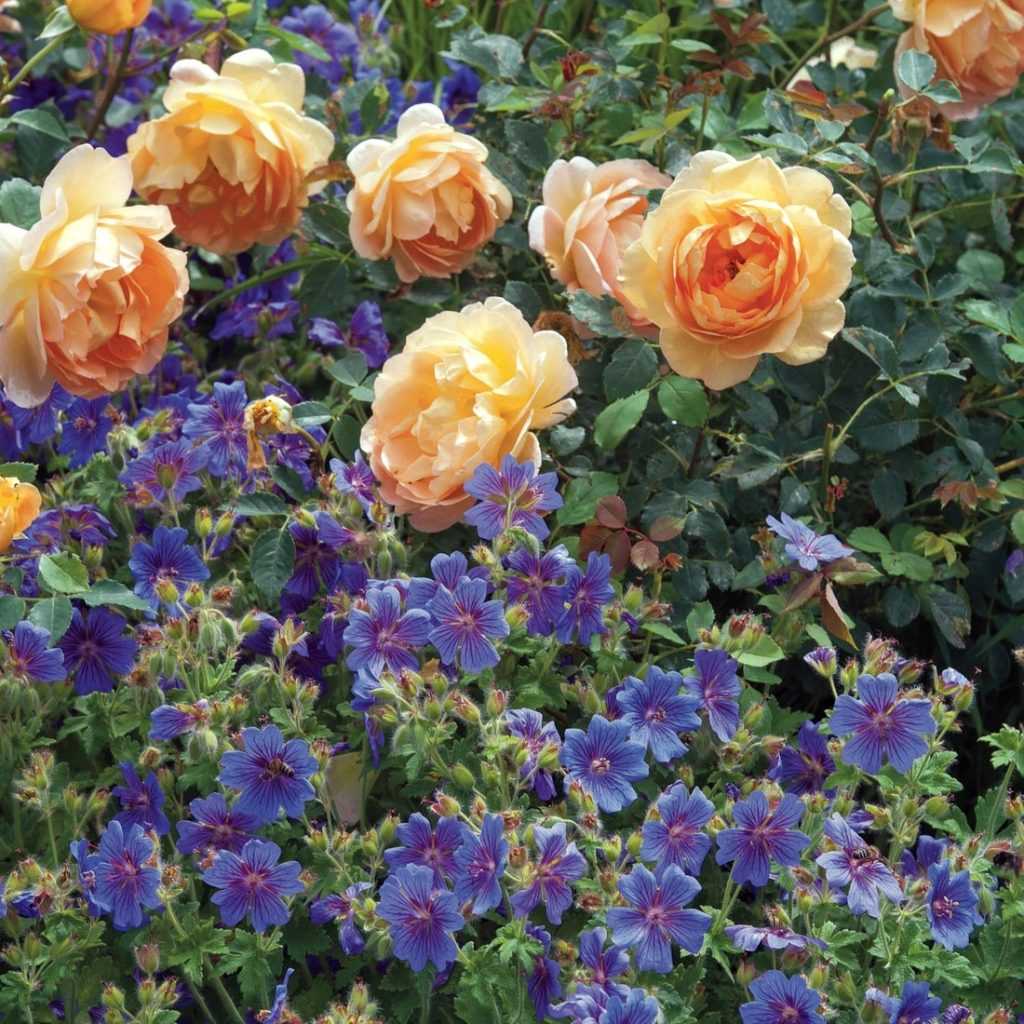
The rose ‘Lady of Shalott’ with Geranium magnificum ‘Rosemoor’ (copyright Biosphoto Friedrich Strauss)
The hardy geranium is no less impressive than the pelargonium, the “king of balconies.” Planted in a pot or planter, it beautifully colours windowsills and terraces! Some varieties like ‘Azure Rush’ or ‘Ann Folkard’ have long stems that cascade gracefully over the edges of containers.
The pink, blue, or white blooms of the geranium create a romantic and delicate atmosphere. It’s perfect for accompanying roses, as well as for integrating into a flowerbed alongside masterworts, sages, lamb’s ears, or alliums. It can also feature in a cottage garden, with its lush vegetation and soft tones. Its understated flowering and broad foliage will add a very natural touch!
Depending on the variety, geraniums make excellent woodland plants (e.g., Geranium nodosum), paired with ferns, while dwarf varieties like Geranium cinereum or Geranium dalmaticum are ideal for rock gardens, thriving in sun and drier soil.
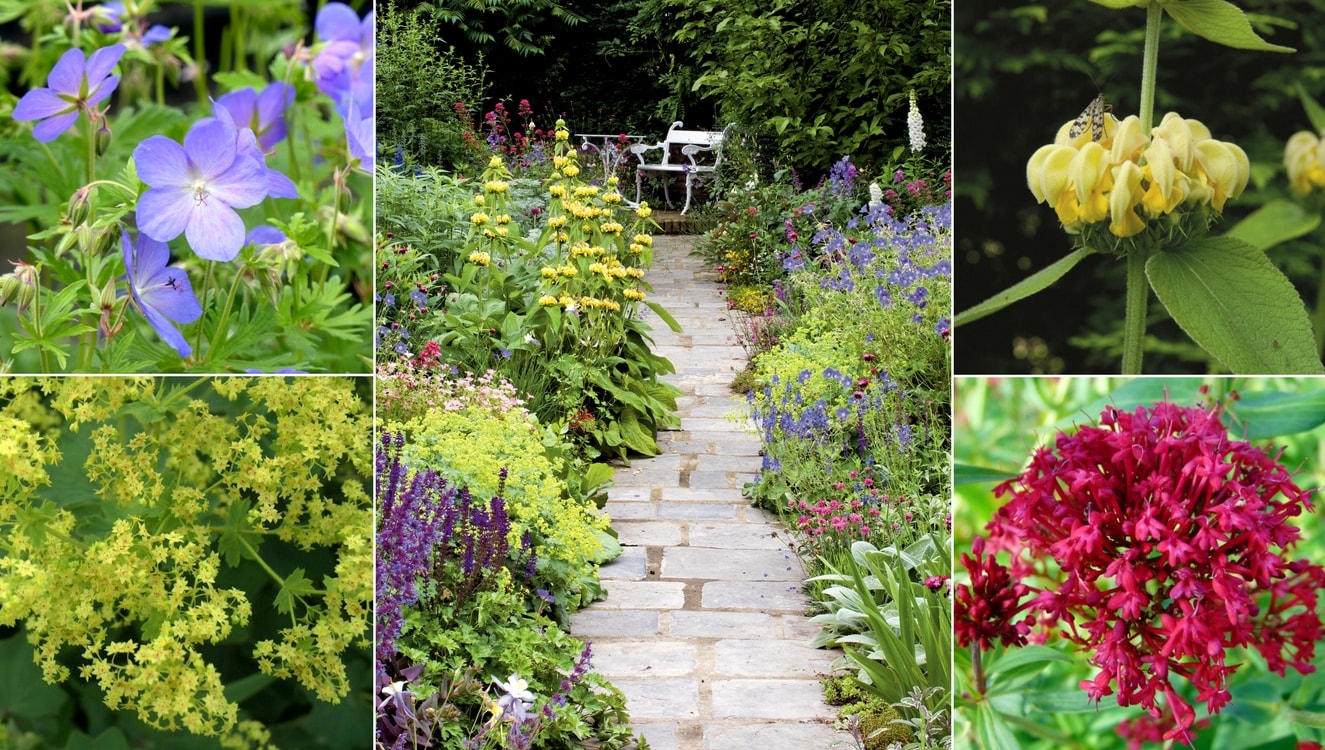
A colourful border scene featuring Geranium ‘Johnson’s Blue’, Alchemilla mollis, Phlomis russeliana, and Centranthus ruber (copyright GAP Photos Elke Borkowski)
… and many more ideas in our companion planting guide “Pairing Hardy Geraniums”
Useful resources
- We offer the finest range of hardy geraniums!
- Our advice sheet: How to plant hardy geraniums?
- Our advice sheet: How to divide hardy geraniums?
- Video – How to plant perennials?
- Video: How to prune and care for ‘Blue Sunrise’ geranium
- An article by Didier Willery, published in L’Ami des Jardins et de la Maison (April 2014): Hardy Geraniums, we all love them!
- Francis Peeters talks about ‘Dragon Heart’ geranium
- The website of Dominique Evrard, who created the national collection of hardy geraniums
- Our advice sheets: 8 hardy geraniums for beginners; Drought-tolerant hardy geraniums; 8 blue-flowered hardy geraniums; 9 pink-flowered hardy geraniums
- Discover Geranium ‘Rozanne‘ in Olivier’s video and Geranium macrorrhizum
Frequently asked questions
-
The leaves of my geranium are covered in a white, fuzzy coating!
Your geranium is affected by powdery mildew, a fungal disease. Remove damaged leaves and stems and treat by spraying with sulphur. Heat and ambient humidity encourage this disease: avoid confined or overly humid atmospheres, and try not to wet the foliage when watering.
-
Should I add fertiliser?
When planted in the ground, fertiliser is not necessary. We recommend adding some compost at planting time, and possibly more in autumn around the clump, especially if your soil is poor. For potted plants, you can apply liquid fertiliser every two to three weeks. Use a balanced fertiliser, not too high in nitrogen.
-
My geranium lacks vigour, it's flagging and not growing
Cut back the clump severely after flowering. This encourages the emergence of new foliage and more vigorous shoots, and may allow for a second flowering. Also divide your plant to rejuvenate it. If needed, you can add a little fertiliser.
-
My geranium is dying back at the centre of the clump
Over time, some geraniums spread outwards but tend to become hollow at the centre of the clump. They should be divided regularly, on average every four years. This helps rejuvenate the plant and restore its vigour.
- Subscribe!
- Contents



































